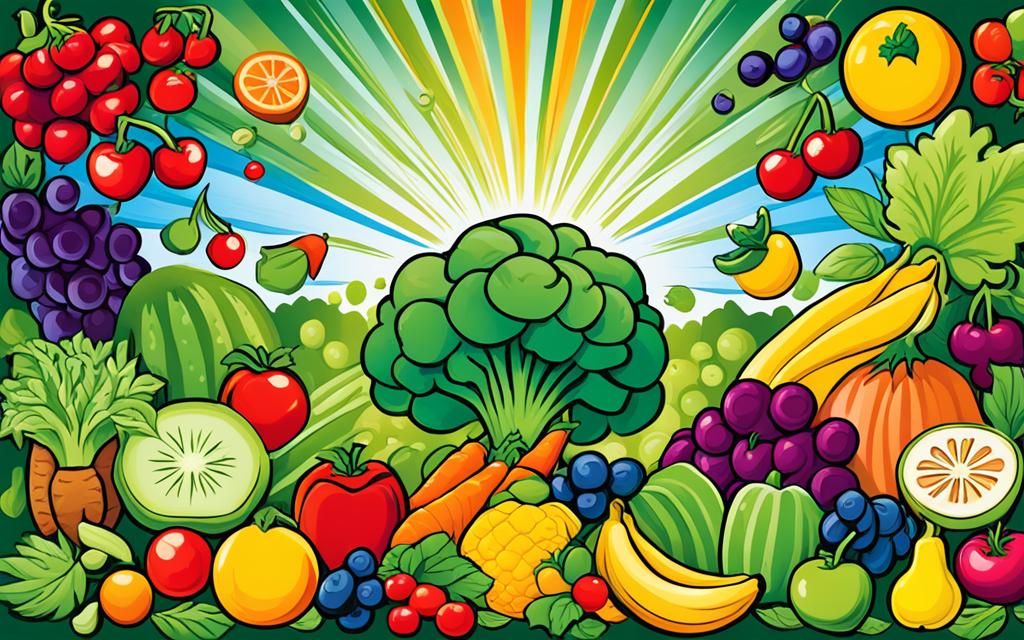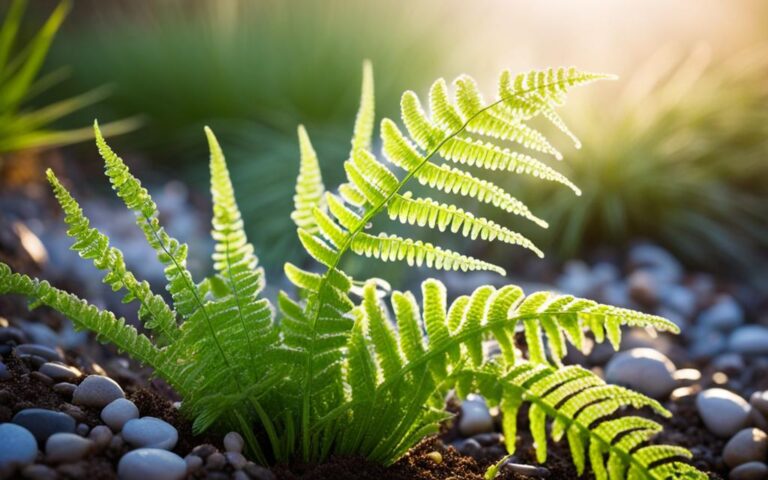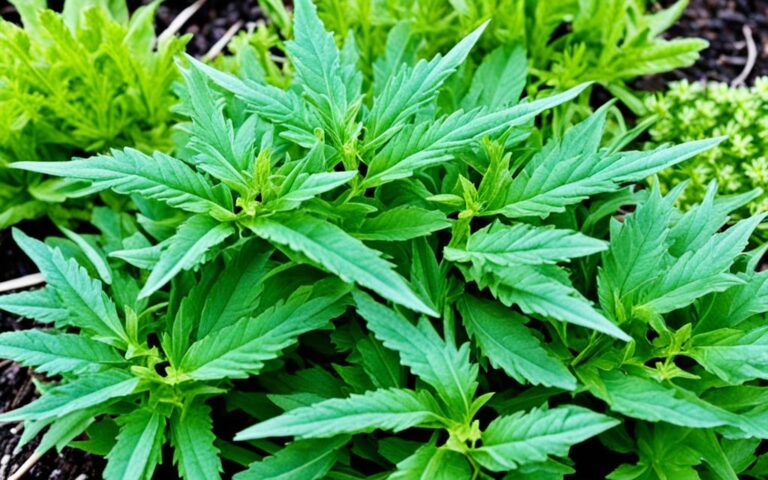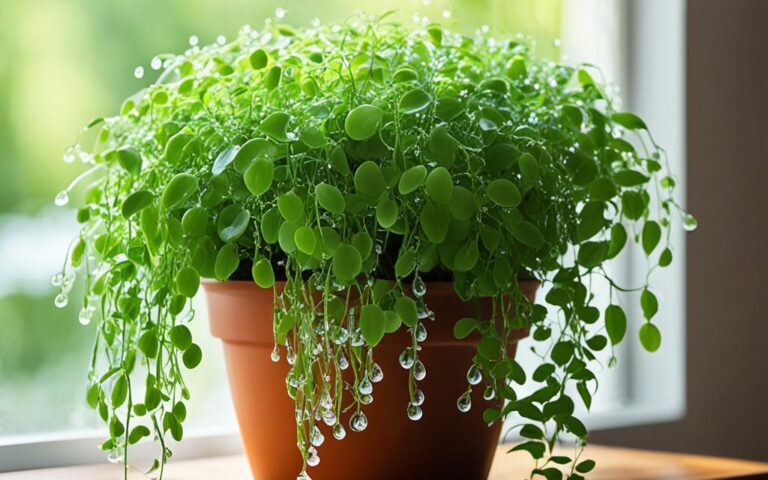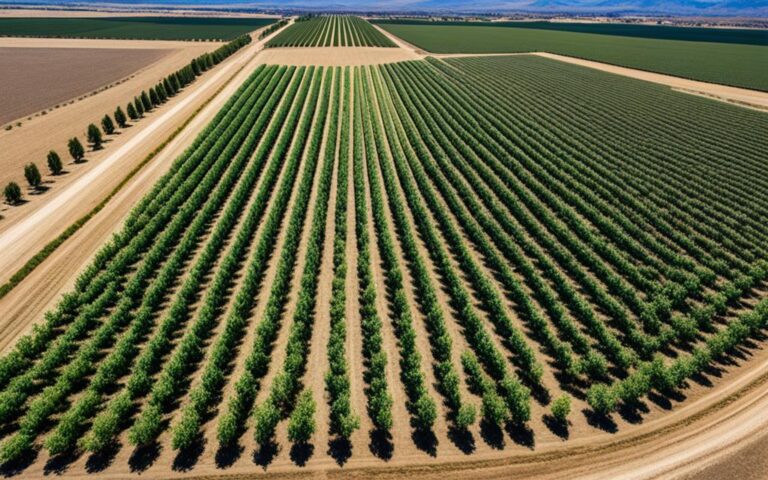Plant Food: Essential Nutrients for Healthy Growth
Plants need 16 key nutrients to grow well and reach their best potential. These include nitrogen (N), phosphorus (P), and potassium (K), which are the main nutrients. Then there are secondary nutrients like calcium (Ca), magnesium (Mg), and sulfur (S). Plus, there are micronutrients such as iron (Fe), manganese (Mn), zinc (Zn), copper (Cu), boron (B), molybdenum (Mo), and chloride (Cl).
Without these nutrients, plants can’t complete their life cycle and may die. But, it’s important to get the balance right. Too many nutrients can harm plants too.
Knowing the role of each nutrient helps gardeners and growers give their plants the right food. This leads to healthy, productive plants. This article will cover why plant nutrition is key and how to give plants the best nutrients for a good harvest.
Key Takeaways
- Plants require 16 essential nutrients to grow and develop properly.
- The primary macronutrients (N, P, K) are needed in the largest quantities for plant growth.
- Secondary macronutrients (Ca, Mg, S) and micronutrients (Fe, Mn, Zn, Cu, B, Mo, Cl) are also essential.
- Maintaining the right balance of nutrients is crucial, as both deficiencies and excesses can harm plants.
- Understanding the role of each nutrient can help gardeners and growers optimize plant nutrition and achieve healthier, more productive plants.
Introduction to Plant Nutrition
Plants need certain essential elements to grow and thrive. These elements are called plant essential nutrients. Without them, a plant can’t complete its life cycle. It might not germinate, grow right, or produce seeds.
But, having too many nutrients can also be bad for plants. It can harm or even kill them.
Importance of Essential Nutrients
The 16 essential nutrients are key for plants. They help with photosynthesis, breathing, and making structures. They also help produce enzymes, hormones, and other important compounds.
These nutrients keep plants healthy and productive.
Classification of Plant Nutrients
Plant nutrients are grouped by how much plants need them:
- Primary macronutrients: Nitrogen (N), Phosphorus (P), and Potassium (K)
- Secondary macronutrients: Calcium (Ca), Magnesium (Mg), and Sulfur (S)
- Micronutrients: Boron (B), Chlorine (Cl), Copper (Cu), Iron (Fe), Manganese (Mn), Molybdenum (Mo), and Zinc (Zn)
Knowing the role and balance of these nutrients is key for healthy plants.
“Plants have specific nutritional requirements, and a delicate balance of essential nutrients is necessary for their optimal growth and development.”
Primary Macronutrients
Nitrogen, phosphorus, and potassium are key nutrients plants need in large amounts to grow well. They help with everything from making leaves green to making energy and building plant structure.
Nitrogen makes leaves green and helps produce chlorophyll, the color pigment. Phosphorus is important for roots, energy, and making flowers and fruits. Potassium helps plants hold water, resist drought, and fight diseases.
If plants don’t get enough of these nutrients, they can show signs like yellow leaves, slow growth, and misshapen fruits. It’s important to check on plants and use the right fertilizers with the right mix of N-P-K to keep them healthy and productive.
| Nutrient | Role in Plants | Deficiency Symptoms |
|---|---|---|
| Nitrogen (N) | Promotes green, leafy growth and chlorophyll production | Leaf yellowing, stunted growth, reduced yields |
| Phosphorus (P) | Facilitates energy transfer, root development, and flower/fruit formation | Slow growth, purple or reddish leaf discoloration, poor root development |
| Potassium (K) | Regulates water retention, drought resistance, and disease resistance | Leaf browning or yellowing between veins, reduced growth and yield |
Getting the right balance of nitrogen, phosphorus, and potassium is key for plants to grow well. By knowing what each nutrient does and what happens if there’s not enough, growers can make better choices. This helps plants get the nutrients they need.
Nitrogen: The Growth Element
Nitrogen is key for plant growth and development. It’s a main part of proteins and is vital for many reactions and photosynthesis. Healthy plants have about 3 to 4 percent nitrogen in their leaves.
Nitrogen Deficiency Symptoms
When plants lack nitrogen, they show clear signs. They turn light green or yellow and grow slower, shedding leaves early. This yellowing starts on older leaves, as nitrogen moves to new growth.
Environmental Reactions of Nitrogen
Nitrogen changes a lot in soil, going through different processes. It’s mostly in organic forms, ammonium, and nitrate ions. Nitrate is more likely to be lost than ammonium.
The nitrogen cycle is important for plants. It adds nitrogen to soil and some plants fix it with bacteria. But, how we manage crops affects nitrogen levels, making it crucial to balance it for plants and the environment.
“Nitrogen is the growth element that promotes green, leafy growth in plants.”
Phosphorus: The Energy Facilitator
Phosphorus is a key nutrient for plants. It helps move carbohydrates from leaves to flowers, fruits, roots, and storage areas. This process is crucial for the plant’s growth and development.
Phosphorus stays put in the soil, making it easier to handle. But, not having enough phosphorus can cause plants to grow poorly, have dead spots, and turn purple or red. It’s important to keep phosphorus levels right to help plants grow well.
Too much phosphorus can harm the environment by causing pollution. But, new farming methods have improved how we use phosphorus. Now, we use special fertilizers and nanofertilizers that help plants get phosphorus without harming the environment.
| Phosphorus Role | Deficiency Symptoms | Sustainable Phosphorus Management |
|---|---|---|
| Facilitates energy transfer and carbohydrate transport | Stunted growth, dead tissue, purple/reddish coloration | Controlled-release fertilizers, phosphorus nanofertilizers, foliar applications |
Learning about phosphorus and new ways to manage it helps us use this nutrient better. This is good for plants and the planet.
“Phosphorus utilization has been a key focus in sustainable agriculture.”
Potassium: The Regulator
Potassium is key to keeping plants healthy and growing well. It’s essential for many plant functions like photosynthesis, controlling water, and helping enzymes work right. Potassium also helps plants deal with drought, fight off diseases, and stay strong through the winter.
Potassium Deficiency Signs
Knowing when plants lack potassium is important for their health. A big sign is when older leaves start to turn yellow at the edges. Plants may grow slowly, have weak roots, and lean or fall over. This nutrient is water-soluble and can be affected by other minerals like magnesium and calcium.
Potassium is crucial for many plant processes. It helps plants grow and develop healthily. By spotting signs of potassium lack, growers can act fast to feed their plants right.
| Potassium’s Role in Plants | Impact of Potassium Deficiency |
|---|---|
|
|
Potassium is a vital part of plant growth and health. Knowing how to spot its lack is key to keeping plants strong and healthy.
Secondary Macronutrients
While nitrogen, phosphorus, and potassium are key for plant growth, calcium, magnesium, and sulfur are also vital. They help keep plants healthy and strong. These nutrients are needed in smaller amounts but are just as important.
Calcium: The Structural Backbone
Calcium is key for healthy roots, leaves, and plant structure. Without enough calcium, plants may have weak roots, soft leaf tips, and “pops” in peanuts. Since plants can’t move calcium around easily, young leaves and growing points show deficiency first.
Calcium is crucial for keeping cell walls strong. This makes the plant’s structure sturdy and able to withstand stress. It also helps roots grow strong, which is key for getting nutrients and water.
“Calcium is the structural support that helps plants stand tall and resist environmental stresses.”
Keeping calcium levels right is key for plant health and productivity. By knowing how calcium helps, growers can make better nutrition plans. This leads to strong, healthy plants.
Magnesium: The Photosynthesis Enabler
Magnesium (Mg2+) is a key mineral for plant health and growth. It’s a part of chlorophyll, which helps plants make their own food through photosynthesis. This process is vital for plant growth and health.
Magnesium does more than help with photosynthesis. It also supports phosphate metabolism and plant breathing. Without enough magnesium, plants may make less chlorophyll and their enzymes won’t work right. This hurts their ability to make food.
When plants lack magnesium, older leaves turn yellow, bronze, or reddish, but the veins stay green. Too much potassium can also cause magnesium deficiency, especially if the soil has just enough magnesium.
Magnesium is common on Earth, making up about 13% of the planet. In plants, it’s a small part, but crucial. Most of it is in chloroplasts, where photosynthesis happens. In some cases, magnesium can make up to 50% of these organelles.
Plants take in magnesium through their roots. The best soil pH for magnesium is between 5.5 and 6.5. Keeping magnesium levels right is important. Too little can hurt chlorophyll production, enzyme work, and photosynthesis, making plants weaker.
Magnesium is vital for photosynthesis and plant health. Knowing its importance helps growers keep their plants healthy and productive. This ensures a strong, sustainable farm ecosystem.
Sulfur: The Protein Builder
Sulfur is key for plant growth and development. It helps make essential amino acids and proteins. It’s one of the 17 essential nutrients for plants, making up about 90% of the sulfur they have. This sulfur goes into making amino acids like cysteine, cystine, and methionine.
Sulfur Deficiency in Plants
Plants with too little sulfur may look pale green or yellow, especially their young leaves. This is because sulfur helps make chlorophyll, the green pigment in plants.
Sulfur shortages are often seen in sandy soils, especially in cool, wet weather. This slows down the release of sulfur from organic matter. Without enough sulfur, plants grow poorly, produce less, and have lower quality crops.
Sulfur is very important for plants. It’s needed for making proteins, producing oil in oilseed crops, and keeping plants healthy. By knowing how sulfur helps plants, farmers and gardeners can make their plants grow better and increase their crop yields.
| Nutrient | Role in Plants | Deficiency Symptoms |
|---|---|---|
| Sulfur |
|
|
Micronutrients: The Essentials
Micronutrients are key for plant growth, even though they are needed in small amounts. They include boron, chlorine, copper, iron, manganese, molybdenum, and zinc. These nutrients are vital for plants to grow and stay healthy.
Not having enough micronutrients can hurt plant health and how much it produces. For example, boron helps with cell walls, roots, and flowers and fruits. Zinc is important for enzymes, making proteins, and making auxin, which helps plants grow. Manganese is key for photosynthesis and fighting off harmful substances.
It’s important to make sure plants get enough micronutrients to grow well and produce a lot. Testing the soil can show if there are any shortages. Then, using the right fertilizers can fix these problems. Knowing about micronutrients and their roles helps growers take better care of their plants.
| Micronutrient | Function | Deficiency Symptoms | Recommended Daily Intake |
|---|---|---|---|
| Boron | Cell wall formation, root growth, flower and fruit development | Stunted growth, yellowing of leaves, brittleness of stems | 0.3-4.5 lbs per acre |
| Zinc | Enzyme function, protein synthesis, auxin production | Stunted growth, leaf discoloration, reduced fruit set | 2-2.5 lbs per acre |
| Manganese | Photosynthesis, antioxidant defense systems | Interveinal chlorosis, grey or brown spots on leaves | 15-75 lbs per acre |
| Iron | Chlorophyll production, electron transport in photosynthesis | Interveinal chlorosis, yellowing of young leaves | Foliar application of iron sulfate or chelated iron |
Understanding the roles of micronutrients in plant growth helps growers make sure their crops get what they need. Regular soil tests and using the right fertilizers keep micronutrients balanced. This leads to healthier and more productive plants.
plant food Sources
Plants are key to our food system, giving us the nutrients we need to grow and be healthy. They get these nutrients from many sources, like inorganic and organic matter. Knowing about these sources helps us grow plants that are full of nutrients.
Inorganic Fertilizers: Rapid Nutrient Delivery
Inorganic fertilizers are made and dissolve in water. They give plants a fast dose of nutrients like nitrogen, phosphorus, and potassium. These are important for plants to grow strong and healthy. But, we must use them carefully to prevent harm to the environment.
Organic Fertilizers: A Natural Approach
Organic fertilizers come from things like animal manure, compost, or plant parts. They give nutrients to plants slowly, which is good for their natural growth. Using organic fertilizers also makes the soil better, helping plants and the environment.
Choosing between inorganic and organic plant food sources depends on what plants need and the environment. Knowing the good and bad of each helps us make the best choices. This way, we can help plants grow well and protect the earth.
Soil Testing and Fertilizer Application
Proper soil testing is key to finding the right fertilizer for your plants. It helps you know what nutrients your soil lacks. This way, you can give your plants what they need for healthy growth and high productivity. Soil tests tell you about soil texture, organic matter, pH, and nutrient levels like nitrogen, phosphorus, and potassium.
In the U.S., especially in the Southeast, many soils are acidic. Some soils in North Carolina are as acidic as vinegar, with a pH of 4.0. This acidity affects how plants get nutrients. A soil pH between 6.0 and 6.5 is best for most plants, helping them absorb nutrients well.
Soil tests show if your soil lacks nutrients or has too much of something. This info helps you choose the right fertilizer. For example, blueberries and rhododendrons do well in acidic soils with a pH of 5.0 to 5.5. Other plants like different pH levels.
It’s good to test your soil every two to three years for sandy soils and every three to four years for clayey soils. Make sure to take samples from areas that are typical of your garden, avoiding wet spots or places with compost piles.
| Soil Nutrient | Optimal pH Range | Deficiency Symptoms |
|---|---|---|
| Nitrogen (N) | 6.0 – 7.0 | Yellowing of leaves, stunted growth |
| Phosphorus (P) | 6.0 – 7.0 | Purplish or reddish leaves, poor root development |
| Potassium (K) | 6.0 – 7.0 | Curled, scorched leaves, slow growth |
By doing soil testing and using the right fertilizers, you can make sure your plants get what they need. This helps them grow well and be productive. It also keeps the environment safe from too much fertilizer or nutrient runoff.
Environmental Considerations
Gardeners and growers need to think about how their actions affect the environment. When adding nutrients to plants, it’s important to do it in a way that doesn’t harm the environment. This means avoiding nutrient leaching and runoff.
Too many nutrients, like nitrogen and phosphorus, can wash away easily. This leads to polluted water and eutrophication. Eutrophication harms aquatic life by causing algal blooms and reducing oxygen levels. This hurts wildlife and makes water unhealthy.
Soil type, how much organic matter it has, and its pH level affect how nutrients work and how they might get into the environment. Knowing these things helps gardeners and growers grow healthy plants and protect the planet.
| Environmental Impact of Plant Nutrition | Percentage |
|---|---|
| Food production accounts for over a quarter (26%) of global greenhouse gas emissions | 26% |
| 70% of global freshwater withdrawals are used for agriculture | 70% |
| 78% of global ocean and freshwater eutrophication is caused by agriculture | 78% |
Nutrient Leaching and Runoff
Nutrient leaching happens when too many nutrients, like nitrogen and phosphorus, move through the soil into groundwater or water bodies. This makes drinking water dirty and harms the environment.
Nutrient runoff is when nutrients from the soil get into water through surface water flow. This can happen during heavy rains or when plants are watered too much. These nutrients then pollute the water.
- Using fertilizers at the right time and amount helps prevent nutrient loss.
- Cover crops and healthy soil help keep nutrients in the soil and reduce harm to the environment.
- Using precision farming, like soil tests and applying nutrients as needed, cuts down on waste and improves nutrient use.
By knowing how to manage nutrients well, gardeners and growers can take care of their plants and protect nature at the same time.
“Even if we stopped burning fossil fuels tomorrow, emissions from food alone could surpass the carbon budget for 1.5°C or 2°C.”
Conclusion
Plants need a balance of essential nutrients to grow well. By knowing about primary, secondary, and micronutrients, gardeners can give their plants what they need. It’s important to test the soil, choose the right fertilizers, and apply them correctly.
This way, gardeners can grow healthy, productive plants. They help the ecosystem by supporting biodiversity and preventing problems like nutrient pollution. A balanced approach to plant nutrition is key for a thriving farm or garden.
By following the best practices in plant nutrition, gardeners can make their plants strong and healthy. They ensure their plants get all the nutrients for great growth and lots of food. This helps make plant-based food production sustainable and keeps the environment healthy.
